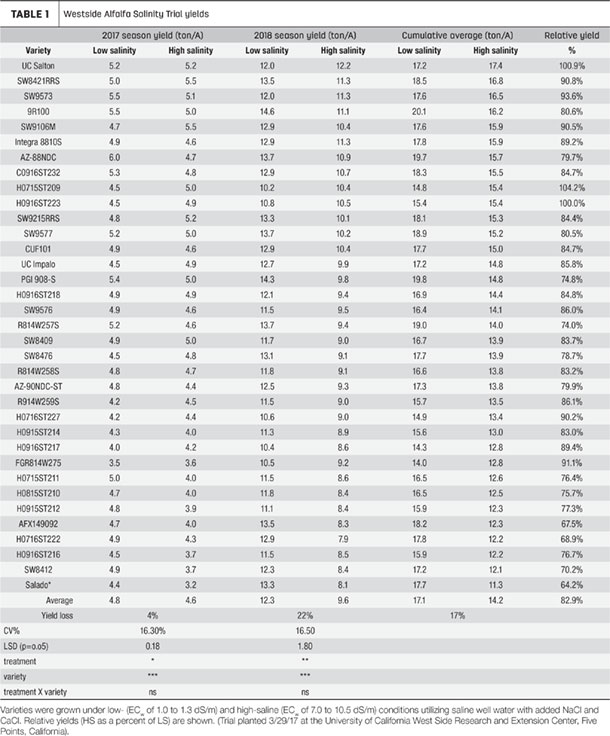This project was undertaken starting in 2009 in an effort to seek better varieties that will sustain yields and perhaps even thrive when grown under saline conditions. Salinity is a major challenge for alfalfa growers in irrigated regions and even in many non-irrigated regions.
Nearly 5 percent of U.S. alfalfa is produced in the Western region, mostly under irrigation. It’s estimated 20 percent of the world’s agricultural land is affected by salinity. Often, “degraded” water (from municipal sources, irrigation drainage, saline wells, animal facilities or food processing facilities) is more available than fresh water for irrigation.
Furthermore, so-called “higher-value” crops (vegetables, orchards, vines and specialty crops) are likely to be grown on the best land and available water, competing with alfalfa and grain crops, a trend to be exacerbated in the future. Thus, cropping systems and varieties of alfalfa adapted to a more saline future are needed.
Click here or on the image above to view it at full size in a new window.
We started this research with essentially zero funds and were highly grateful for the (later) contribution of the Alfalfa Checkoff funds and the USDA-AFRP. Current field trials were conducted in western Fresno County (a saline region), utilizing specialized reservoirs and injection of highly saline water directly to alfalfa root systems utilizing both surface and subsurface drip irrigation systems. Further trials are planned for Utah in the coming year.
The objectives were to test the relative performance of alfalfa cultivars under high salinity in a replicated trial, determine the economic viability of alfalfa crop production under high-saline conditions and to develop new germplasm and varieties utilizing screening plots at high salinity. In this case, we utilized very high-salt-containing water, water most farmers would like to avoid using.
However, it was important from our earlier trials that we needed to intensify the salinity levels of field trials to try to detect tolerance levels. High-salinity (HS) irrigation levels were compared with low-saline (LS) controls utilizing a split plot design. Two field trials were a part of this project. Yields averaged 89 percent of LS plots over 2014 to 2017 in Trial 1.
In Trial 2, yields averaged 95 percent and 78 percent of non-saline controls in 2017 and 2018, respectfully, indicating the buildup of salinity effects over time. Over the two years of the study, the variety x salinity interaction was non-significant, unfortunately, and these trials will be continued to detect variety difference over time. Aerial images show distinct stress provided by the salinity in midsummer, but crops were mostly able to recover under milder conditions in the fall.
Alfalfa yields under HS were economically viable for this region (average yield under HS was 9.6 tons per acre). This research, along with greenhouse and sand tank research, indicates a much higher level of salinity tolerance for alfalfa in general, which directly contradicts textbook values which predict alfalfa yield decline at low (EC=2.0) salinity. Ongoing research will focus on the variety issues and identification of genes associated with salinity tolerance.
Since long-term effects of salinity are so important, our objectives remain to continue these trials until 2020 to test variety response to salinity and measure long-term effects of salinity on crop response to yield and quality.











